
October 2010
John Vincent Bellezza
We embark on another flight with the great horned eagle across the very crown of Planet Earth. This month’s issue focuses on discoveries made on my recent Upper Tibetan Rock Art Expedition (UTRAE) and also on earlier campaigns. So without further adieu, let’s fly away!
The deer: symbol of well-being, sacrifice and the divine
Although not as common as the wild yak (’brong), a great many deer pictographs and petroglyphs are found in the rock art of Upper Tibet. Except for its eastern and southern fringes, this highest portion of the Tibetan Plateau no longer supports cervid species. Nevertheless, evidence from the rock art tableau indicates that as late as the early historic period (circa 650–1000 CE), deer were widely distributed in the region. Perhaps the last deer of the Changthang became extinct only several generations ago. Until recently, musk deer (gla-ba) are said to have ranged in the dwarf willow forests of the Nam Tsho basin. A well-known Bon lay practitioner from Kanglung (Gangs-lung) village at Lake Dangra had deer antlers erected on his roof top shrine (gsas-mkhar) as part of a receptacle for the household divinities. This large rack is supposed to have come from a deer that lived near the lakeside. In the early 2000s, a deer skeleton complete with horns was unearthed at Lake Dangra. These remains are considered sacred by local villagers and are used in concocting healing substances.
The principal deer of the Changthang was the white-lipped deer (Cervus albirostris), a species endemic to the Tibetan Plateau. The habitat of the Tibetan red deer (Cervus elaphus wallici), which has a reddish brown coat and a white patch on the rump, is likely to have extended into lower elevation regions of Upper Tibet as well. We can infer that colder and drier conditions and the concomitant loss of steppe and scrub biomes led to cervid extinctions in Upper Tibet. The many scenes of deer hunting in the rock art of the region suggests that overhunting may have also played a major role in the demise of deer (a reference to deer hunting in the prehistoric context is found in the archaic ritual text Klu ’bum nag po; see my book Zhang Zhung, pp. 482–489).
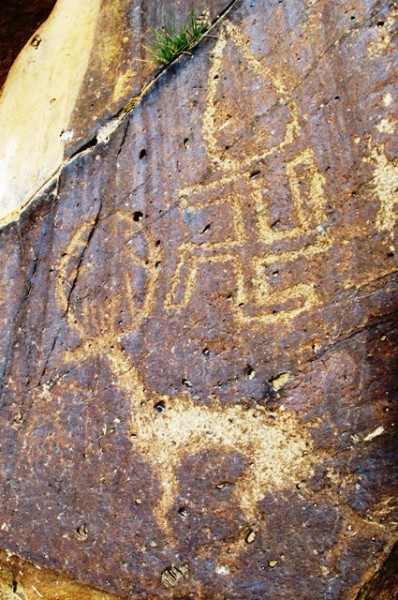
Fig. 1: The stag as a sacred animal, early historic period. The swastika with the teardrop-shaped symbol above (possibly representative of the sun) clearly indicate that this carving portrays a ceremonial or divine form of the deer. A study of the cultural history of Upper Tibet encourages the view that this cervid may have been an ancestral, territorial and/or protective spirit
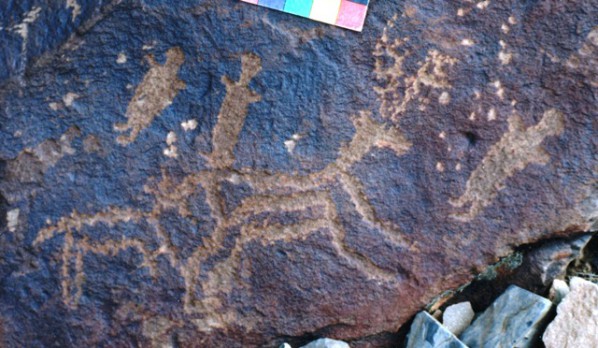
Fig. 2: What appears to be a deer and another ungulate in conjunction with three anthropomorphic figures, protohistoric period (circa 200 BCE to 650 CE). The anthropomorphs are shown in a non-threatening attitude without the weapons of hunters, strongly suggesting a mytho-ritualistic or possibly an economic role for the animals

Fig. 3: A magnificent bounding deer carved in isolation, prehistoric epoch (Iron Age or protohistoric period)
Deer in non-hunting religious contexts are known in rock art and in that class of copper alloy talismans known as thokchas (thog-lcags). These lovely renditions of often single animals come in a surprising range of styles and aspects, reflecting their creation over a very long period of time. As noted in my book Zhang Zhung (pp. 173–175), solitary deer in Upper Tibetan rock art were probably carved and painted for a number of reasons. Most simply they may have been made to beautify rock panels or as a recreational pastime. It is very likely that deer art was also executed under a more complex set of compulsions. We can hypothesize that creations may have been created as magical charms to increase the supply of wild game or to insure a successful outcome for hunting expeditions. Perhaps deer were depicted on rocks after the hunt as a gesture of thanksgiving. We simply cannot say conclusively one way or the other. In addition to these more prosaic functions, certain deer depictions in Upper Tibetan rock art may well represent divine figures in zoomorphic form. To this day, many indigenous deities of Upper Tibet have cervid attributes or ride deer. For instance, the goddess Lekyi Wangmo (Dang-ra las kyi dbang-mo) of Lake Dangra and members of the long-life sisterhood (Tshe-ring mched lnga) are mounted on deer. The Bon wind god (rlung-lha) also uses the deer as his vehicle. Furthermore, ‘Red Deer Red bTsan of the Slates’ (Sha-dmar g.ya’ yi btsan-dmar), a member of Mount Targo’s circle of spirits, seems to have a cervine form.
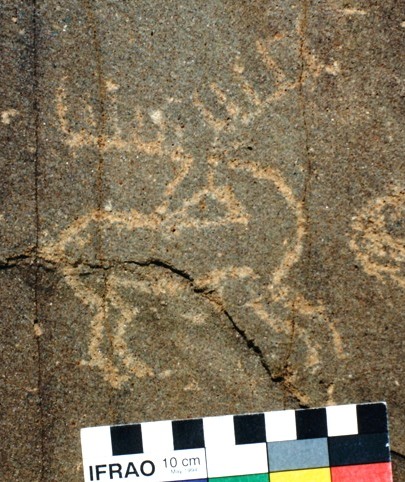
Fig. 4: The head swung back towards the body and the horizontal orientation of the antlers in this specimen recall the animal art of north Inner Asia, protohistoric period. This petroglyph is located in northwestern Tibet, a region of the Plateau that came into close contact with northern cultures such as the Scytho-Siberians

Fig. 5: This panel portrays four different wild ungulates (two yaks, deer and other animal), protohistoric period. The deer is identified by its branched horns. The volute design in the body of the animal is a characteristic feature of ungulate rock art in Ruthok (and to a lesser degree in Ladakh and Zanskar) during the Iron Age and protohistoric period
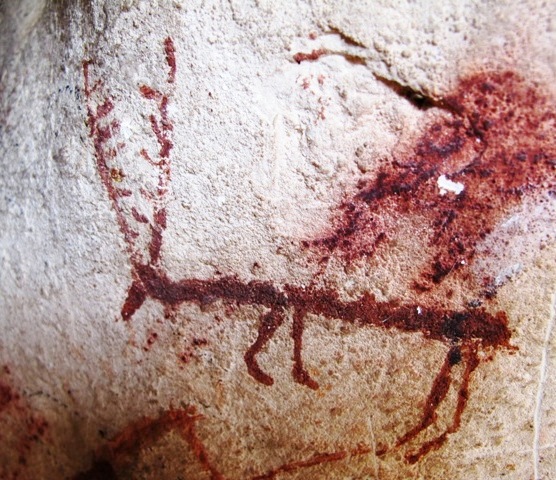
Fig. 6: A wonderfully whimsical depiction of a deer painted in red ochre, probably Iron Age (circa 800–100 BCE). Stick-like figures of deer from the same general time period are also found carved on rocks in Upper Tibet
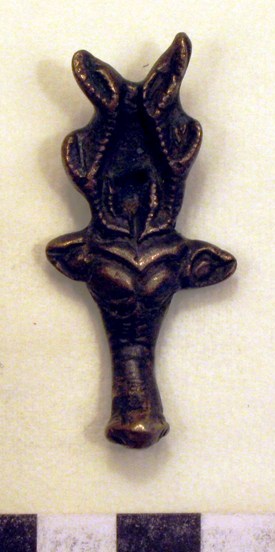
Fig. 7: A copper alloy deer-head pendant, early historic period (?). The aperture on the back of this object demonstrates that it was made for wearing. The exaggerated long snout of the animal seems to convey fecundity or virility
Tibetan historical and ritual texts mention the deer in a variety of magical, iconographic and sacrificial roles. Herds of what may have been tame deer in western Tibet are noted in the Old Tibetan Chronicle, written circa the ninth century CE. As pointed out by the great Tibetologist R. A. Stein (Journal Asiatique, 1970), both divine and demonic deer appear in the Dunhuang manuscripts. In another Old Tibetan text, fighting stags manifest as a portent signaling serious trouble for the protagonist of the tale (see my paper in Revue d’Etudes Tibetains, October, 2010). On the other hand, in an ancient Bon ritual text written in Classical Tibetan, a crystal horned conch deer residing on an island in the north serves as the foundation for the good fortune of human beings (see my Calling Down the Gods, pp. 472–479). In Tibetan archaic funerary rituals, deer have diverse functions (refer to Zhang Zhung for more information). It is written that an unguent was made from deer fat to treat the corpse, deer hide sacks (gshin-sgro) used to protect the soul of the deceased from demonic attacks, and effigies of the demons of death (gshed) made from deer skin. A particularly flagrant case of deer sacrifice, as part of a Buddhist polemic, is found in the biography of Yeshe Tshogyel (Ye-shes mtsho-rgyal). According to an origin tale in the funerary text collection known as Mu-cho’i khrom-‘dur, the deer (along with the cuckoo and crane) was involved in the creation of the first soul stones (bla-rdo), an object that is believed to protect the integrity of both the living and the dead. In a thousand-year old illuminated funerary manuscript I am currently working on for publication, divine deer feature as important guides of the dead, on their passage through the perilious intermediate zone between death and the afterlife. Interestingly, the priest named ‘Deer Horns Versed One’ (mKhas-pa ru-sha) in the Mu-cho’i khrom-‘dur is recorded as being an original expert in mortuary customs.
The Mon burials of Montsher: a preliminary report
For many years I have received reports of a special form of burial in wooden coffins in the Montsher (Mon-’tsher) area of southwestern Tibet. Indeed, this toponym means ‘Traces of the Mon’ in a clear allusion to its ancient cultural makeup. I have been apprised of the locations of these distinctive burials on a number of occasions only to find that the sites had disappeared under fallen earth or picked clean by looters. It was only on the UTRAE that I could obtain solid archaeological evidence. From what I have been able to gather from the oral tradition of Montsher, it appears that its so-called tribe of Mon differed significantly from other ancient peoples labeled ‘Mon’ in Upper Tibet. This is borne out in the recent unearthing of a Mon grave, complete with wooden coffin, near the Bon monastery of Gurgyam (Gu-ru gyam).
In 2006, the lay associates of Gurgyam parked their truck on the plain in front of the monastery. Soon the truck began to sink into the earth. After managing to remove the truck, a huge hollow was discovered underneath where it had been parked. In an affirmation of what they see as their ancient identity, as heirs of the Zhang-zhung kingdom, the monks of Gurgyam began to excavate the cavity that had formed. Three meters down they unearthed a 1.5 m-tall stone-lined chamber covered in rounds of wood (small fragments of which are still in situ). Resting on the bottom of this chamber was a highly fragmented wooden coffin. On top of the coffin were placed various ceramic vessels. Inside the coffin were the bones of a single adult wrapped in a shroud made of yellowish and reddish taffeta. It is said that some of the bones were individually wrapped. The monks add that there may have been bones of a second individual in the grave but they are not very clear here.
Most of the human remains, coffin fragments and other objects were moved into the monastery’s assembly hall for safekeeping. The monks were afraid that the tomb and its contents would be spoiled in the rain and snow and once they secured permission from local authorities, the bones and artifacts were put on display in what is effectively one of Upper Tibet’s only local museums.
Unfortunately, the spatial arrangement of tomb elements and other subsurface data could not be collected by the monks. Still, they must be applauded for salvaging the first Mon burial in Montsher open to scientific investigation.
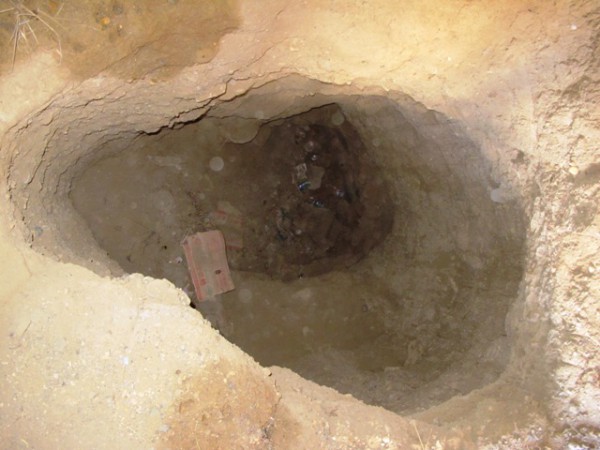
Fig. 8: The 4.5 m-deep burial chamber at Gurgyam. The site is now protected by the construction of a shed over the excavation
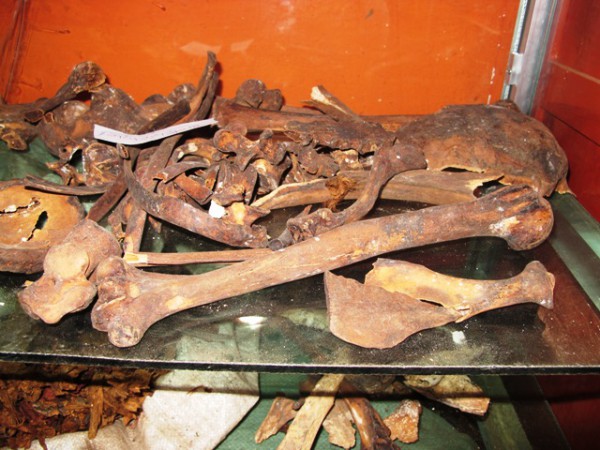
Fig. 9: The human remains from the tomb now stored in the monastery
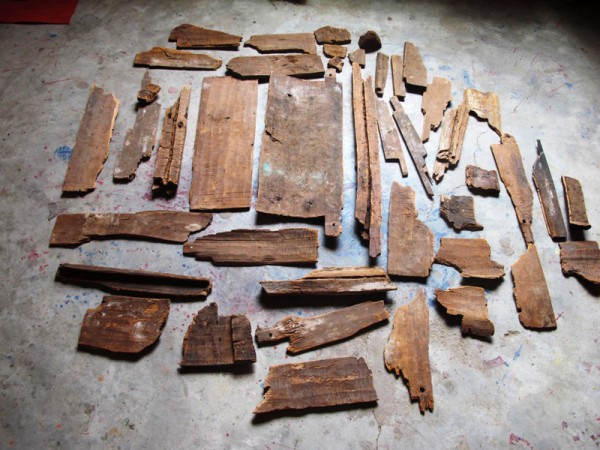
Fig. 10: Some pieces of the coffin arrayed for the photograph. Note the tongue and groove construction
An inventory of major objects on display includes:
Wooden objects
- Top of small wooden container; in shape it is not unlike that of a snuff container lid.
- Flat piece of wood with teeth and rounded edges. This may have been some type of comb
- Wooden tray with four squat legs made of a single piece of wood, 27 cm in length
- Part of another wooden tray 1 cm-long piece of wood with perforation
- Wooden shaft
- Woven bamboo shoe, crafted to a high level of proficiency. The presence of a cane shoe in the tomb indicates that in antiquity Montsher was engaged in Transhimalayan trade and had contacts with peoples of cis-Himalaya origin. A bamboo funerary ritual object was also discovered in a tomb at the Gyaling (rGya-gling) site in Guge, dated to the second half of the first millennium. This instrument also attests to the existence of a cross-Himalayan trade network (see Zhang Zhung, p. 115).
Metal objects
- Two copper alloy bowls with thin walls, simply modeled but very adeptly cast (12 cm and 15 cm in diameter). One of these bowls has a single loop handle
- Copper bowl with rounded bottom, 25 cm in diameter
- Gilt metal fragments thought by the monks to have originally formed a disk
- Iron pin, 10 cm long
- Rounded piece of iron, 13 cm long
- Iron spearhead with flat blade and round socket, 32 cm long. Spearheads of not dissimilar manufacture were used in Tibet until the modern period century
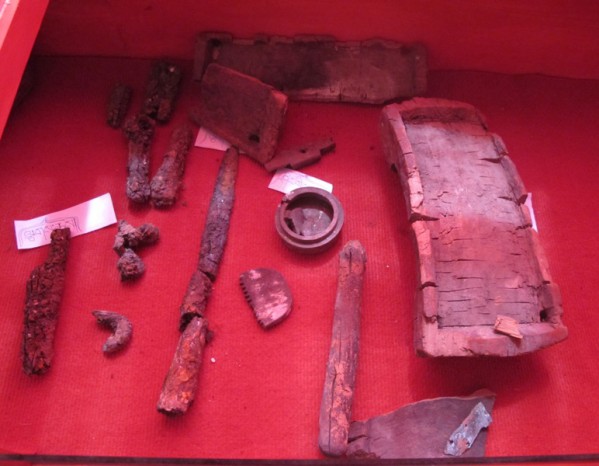
Fig. 11: Wooden tray, circular container, ‘comb’ and other wooden fragments, as well as iron spearhead and other iron fragments
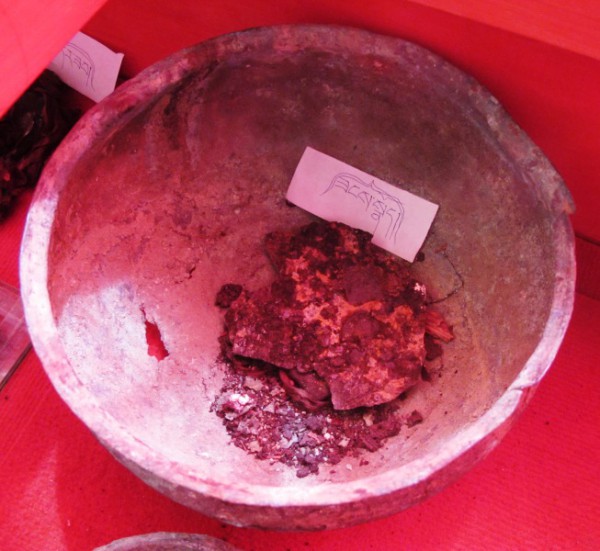
Fig. 12: A vessel made of copper with rounded bottom, 25 cm in diameter
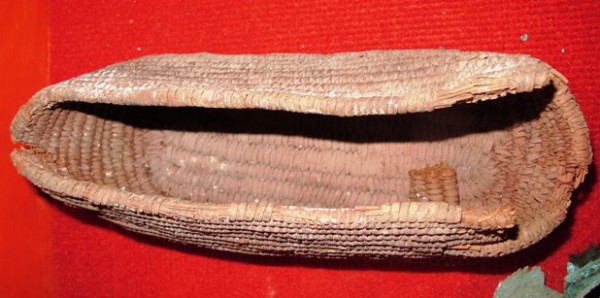
Fig. 13: A well-made cane shoe
Stone objects
- Portion of a rectilinear tool or instrument with a small square hole in a cleaved piece; made of a fine-grained beige stone, 15 cm long Horn object
- An object made of horn broken into many small pieces. The monks believe that it is a ladle
Ceramics
- Cord-marked redware bulbous amphora with lug handles, 34 cm in height. This vessel is completely intact except for a tiny hole in the bottom
- The top 25 cm portion of a beige thinner walled amphora with striated body
- Cord-marked amphora with very wide lug handles and broad mouth, 17 cm in height
- Four thin-walled jugs with rounded bottoms, smooth bodies and single lug handles. The one largely intact specimen is 12 cm in height
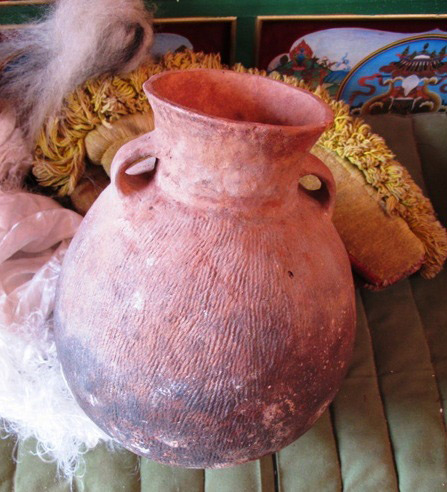
Fig. 14: A cord-marked amphora, 34 cm in height
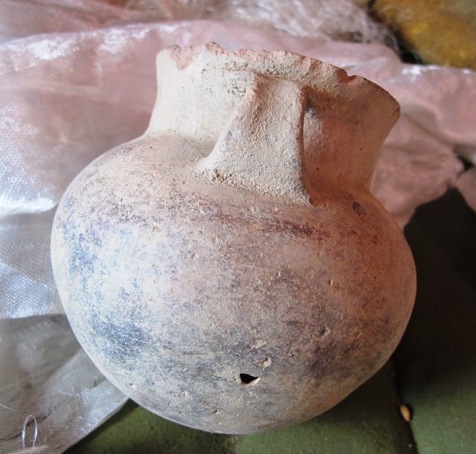
Fig. 15: The most intact of the smaller smooth-walled ceramic jugs
Textiles
- A piece of dark brown woollen serge, not unlike cloth still made in western Tibet
- Finely woven reddish brown and mustard-yellow silk taffeta
- A warp-faced patterned silk with a dark blue ground and beige designs, measuring 44 cm x 25 cm. This piece of cloth is said to have been bunched up inside the fragmented cranium of the corpse. Experts in textiles have tentatively identified this textile as dating to the Han dynasty but further inquiry is demanded. This silk has three horizontal registers of figures, each of which features different sets of zoomorphic ornamentation. There are also the remains of a border with a more abstract design. In the top register is a series of what appear to be tigers, with mouth agape, three stripes and what may be a wing. The middle register is comprised of four fully intact compartments, each of which contains a pair of peacocks and a pair of what may be carnivores along a central axis framed by two more pairs of animals. The lower register is dominated by five cartouches, in each which is a pair of affronted waterfowl. The place of discovery of this textile puts it in a geographically intermediate position between the silks of China and those manufactured by the Persian Sassanids after circa 225 CE. The deposition of what was surely seen as a valuable commodity in a tomb in southwestern Tibet may require some overhaul in the way we think of the Silk Road. That a branch of it fed into Zhang Zhung territory, to use the traditional attribution, is something that must now be seriously considered. Silk and other trade items could have come down from the oases along the southern margin of the Taklimakan and entered Tibet along the Indus River conduit or through the valleys of Ruthok. In any case, the silk suggests that southwestern Tibet was once part of a far-ranging trade network.
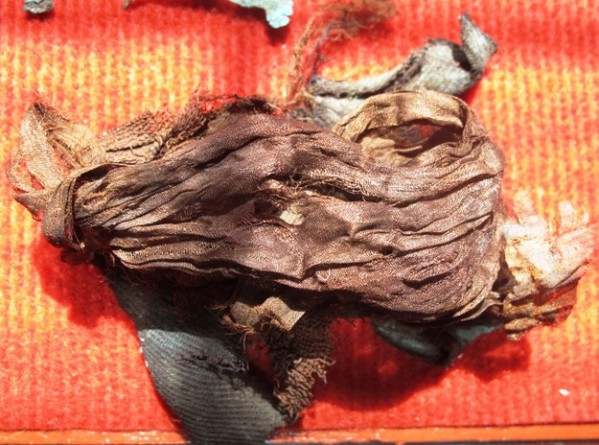
Fig. 16: A fragment of the very ample burial shroud. Underneath it is the woollen cloth recovered from the same tomb
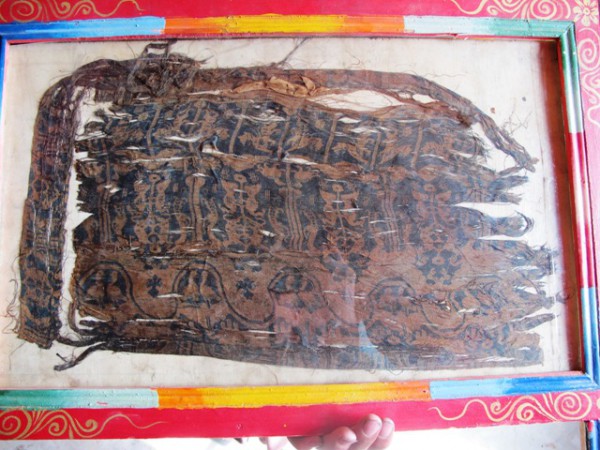
Fig. 17: A warp-faced silk with lavish zoomorphic designs
I have advised the monks of Gurgyam to seek professional aid in protecting this remarkable textile from thieves and the corrupt. Prefectural authorities have assured me that the silk will be afforded every protection under the law of the PRC.
The beams used in the construction of the burial chamber are of softwood (probably willow or poplar). While trees are now scarce in Montsher, the situation some 2000 years ago may have been very different. Even now poplars are being reintroduced in the region.
The ceramics unearthed in Gurgyam are directly comparable to those discovered in the Guge sites of Phyi-dbang, Dung-dkar and Gebusailu by Huo Wei et al., and dated to the second half of the first millennium BCE. As pointed out by another Chinese archaeologist, Yao Jun, the ceramics of far western Tibet differ from those discovered at the Chos-gong (central Tibet) and mKhar-ru (eastern Tibet) sites, strongly suggesting distinctive cultural orientations for these respective regions.
The grave finds indicate that Montsher had well-developed trade relations, with commodities coming from as far away as China. Chinese silks were highly coveted goods, and in the Warring States and Han dynasties they circulated in many corners of Inner Asia. As for the origin of manufacture of the metalware found in the Gurgyam tomb, I am inclined to see them as part of an indigenous metal-working industry. Copper, bronze, iron, and gold articles may all have been produced locally. Be that as it may, the woollen cloth deposited in the tomb was surely made in the general region.
The nature of the Gurgyam grave goods shows that the individual interred (probably male as the size of the skeleton suggests) enjoyed a relatively high socio-economic status, someone who commanded a rich array of material objects. The sheer diversity of implements and the materials from which they were made in the Gurgyam tomb is clear evidence of considerable cultural sophistication. This is also reflected in the ritual complexity evidenced in the manner of burial. The builders of such tombs appear to have been in possession of a fully developed Iron Age technological and cultural system. Far from being the barbarians often visualized in popular Tibetan imagination, the pre-Buddhist dwellers of places such as Montsher were highly civilized people. The next stage of my inquiry is to subject an osteological sample from the tomb to AMS analysis, so that we can more confidently date the burial. I plan to do that this winter, subject to the procurement of funding.
More important archaeological discoveries from Upper Tibet next month and in the months to follow, and other things too!
Supplement: More on the silk recovered from the Montsher burial
Posted November, 2010
I belong to an online scholarly exchange group called the Indo-Eurasian Research List (moderated by Dr. Steve Farmer). In mid-October, I announced to the List my documentation of the ancient silk described and illustrated above. This caused quite a stir among scholars and the jury is still out on where and when this textile was made. I am reproducing comments received from eminent specialists and my responses below. If you too have something to share regarding the Montsher silk, please do let me know. As you shall see, a few comments are also directed towards my discovery of chariot petroglyphs (see August Flight of the Khyung). It is with much appreciation and thanks that I include the knowledge and opinion of experts in my newsletter. I would also like to call the attention of my readers to an excellent paper about silks in imperial period Tibet written by my colleague Dr. Amy Heller entitled, “Recent Findings on Textiles from the Tibetan Empire”. Amy was kind enough to send me a digital copy of her work for which I am most appreciative.
It is possible that the Montsher silk may have been produced in western Tibet, in the protohistoric period (circa 100 BCE–600 CE). If so, this speaks volumes for the sophistication of early western Tibet, a region that was part of the Zhang Zhung kingdom according to various Tibetan historical sources. Indigenous production is predicated on the importation of the silk fibre as well as intimate knowledge of Sino-Indo-Eurasian designs and their underlying intellectual and mythic basis. This would have required not only advanced trade networks but an outward and dynamic culture, one sufficiently confident and accomplished to deal effectively with the broader world.
In addition to the comments below, Professor Victor Mair (Center for East Asian Studies, University of Pennsylvania) in personal correspondence also suggested that the Montsher silk may possibly be of Tibetan manufacture.
First, my initial October 10th announcement on the Indo-Eurasian Research List:
Dear List,
Coming back from the wilds of Upper Tibet, I bring a couple things that may
interest some of you. I was able to document for the first time chariot
petroglyphs at several rock art sites. These chariots are not an exotic or alien feature but are found as an integral part of the mytho-religious fabric of the region. As for the use of chariots in Upper Tibet in war and for political ends, I cannot say much. The discovery of chariot representations epitomizes the transcultural linkages between early Upper Tibet and other regions of Eurasia.
In a burial unearthed recently in southwestern Tibet among the finds was a
Chinese silk, which I think may be from the Han dynasty but I am not sure. If anyone can positively identify this silk, I would be very appreciative.
It would be very fine to initiate a discussion on chariots and silks in the
Indo-Eurasian context of course. So kindly let me know what you know. Thanks!
John Vincent Bellezza
Dr. Heleanor Feltham (The Asian Arts Society of Australia):
Dear John
It’s a wonderful and very exciting find! I was fortunate to be sent some detailed photos of your silk, and it does in many respects resemble Han/Jin textiles excavated in Xinjiang both recently, especially at Shampula, and earlier in the C20th by Marc Aurel Stein, many of which are in Delhi. Also the winged tigers strongly resemble the felines in these Chinese examples. Tigers are an indication that the design is earlier, since Sasanian-style lions on textiles tend to be pretty ubiquitous from the 6th century, both in China and in Central Asia. While there are elements which do more closely resemble Sasanian textile designs, notably the confronted birds, and the overall design with its registers is less free than other examples, the fact that it is warp faced would tend to put it into the Han/Jin period, as later high-end Chinese textiles tend to be weft faced. Do you know if the Tibetan example is compound tabby (early) or compound twill (later)?
The Chinese in the Han dynasty had sumptuary laws covering the more decorative silks, but this also allowed them to be used as ambassadorial gifts, especially to the Xiongnu (in return for horses), and these could well have been traded on – the nomads played a significant role in long-distance trade. Also the zoomorphic and metamorphic elements would suggest designs targeting a nomadic market, Emma Bunker, in her article in the Bulletin of the Asia Institute vol. 6 has argued the Chinese origin of some Ordos and other belt buckles in this style, and if belt buckles, then surely silks. Like the buckles, the silk tigers are mirror images, and their musculature/stripes follow belt buckle conventions.
Are you planning technological dating of the bones, wood and ceramics? And was the body entombed after it had become a skeleton as would seem to be the case from the positioning of the silk and the individual wrapping of some bones.
Heleanor Feltham
Dear Heleanor,
Thanks so much for your learned reply to my call to interested parties. I shall make note of your information in my website, if you do not mind. I know little about silks, and cannot answer your question regarding the nature of the weave (tabby or twill). I do plan to subject one of the human bone fragments from the tomb to AMS analysis. Hopefully this will help in dating the burial and grave goods. As I only came upon the tomb after it had been excavated, I am not certain as to the original status of the burial. As you say, the wrapping of bones in silk seems to be a good indication of a secondary burial, perhaps as part of the mortuary practice of excarnation. The existence of secondary burials
is suggested in Tibetan archaic funerary texts as well.
John V. Bellezza
From Heleanor Feltham:
John,
Have a look at the Niya fragment Aurel Stein collected
http://depts.washington.edu/silkroad/museums/delhi/stein/niya.html
It has birds and felines in registers, separated by scrolling clouds, though not divided into cells, unlike the famous arm-guard from near-by Shampula. Both examples include Chinese characters. Niya finds seem to be principally C1st – C4th CE. Tigers seem to have been a popular theme with Central Asian nomads in the East, they turn up carved on wooden Pazyryk tombs, on Ordos & other belt buckles, and other objects, from at least the C4th BCE.
Cheers,
Heleanor
Heleanor,
Had a look at Niya fragment through link you sent. Does it not seem quite
different, the designs more fluid and elegant than the W. Tibet specimen? I
suppose a close analysis of the weaving technique used would tell us more. I just received an email from a well-known scholar who is not on-list, boldly suggesting that the silk unearthed in W. Tibet may be of indigenous manufacture, something I timidly suggested in my note to Francesco. What do you think? Was silk widely produced in Inner Asia in antiquity? I wonder how much archaeological evidence there is indicating various places of production.
As for tigers in Tibet, later texts strongly suggest that they played a crucial role in the mythology and religion of the pre-Buddhist age (pre-600 CE). Tiger amulets of the thog-lcags class are known in Tibet, some of which appear to be pre-Buddhist, but thus far I have not seen any that are winged.
John V. Bellezza
From Dr. Peter Hardie (Bristol Museum and Art Gallery):
Many thanks for the news of the exciting find at Montsher, and for introducing me to your website – and congratulations to the monks on their handling of their finds.
With respect to Heleanor Feltham, I see some differences between the Montsher patterned silk and, e.g., the Han silks from Niya (Zhao Feng & Yu Zhiyong, “The Legacy of the Desert King”, Hangzhou & Urumqi, 2000). It doesn’t have the brilliant all-over cloud scrolls on which the animals are set, but places them in comparatively simple bands. The border panel with sine wave lines separating the confronted ducks from small floret forms doesn’t look very Chinese to my eyes, and the florets look more M-E- derived Central Asian.
Do any of the teeth of the owner survive?
As regards chariots, I had the idea that four-spoke wheels are primitive and very high numbers of spokes late (and Chinese rather than West Asiatic). Also that the box moved back from the shaft onto the axle. I regret I can’t give a source for this.
Thanks again and good wishes
Peter Hardie
12 Oct 2010
Hello Peter and all,
I do not remember seeing teeth. I rifled through the pile of bones stored in the monastery, but did not attempt any kind of organization of the remains due to time and other limitations. There is of course much that could be done in this area, but for a number of non-archaeological reasons that may not be possible at this time.
I well understand what you mean about the pairs of ducks, and you add the
florets as being rather non-Chinese. Banish the thought, and it is a flagrantly extravagant one, but is there even a shred of possibility that such a silk was produced in western Tibet? I have read more than once that the Chinese jealously guarded the art and science of sericulture, claiming it for their very own, so import of the fiber is not likely? And in any case, western Tibet does not have the right environment for silkworms and certainly not any mulberry trees, at least not recently. By the way, the height of Montsher is around 4300 m and it has a very continental and dry climate.
You and Heleanor both seem to be inclined as seeing eastern and western features in the silk, fitting, even if for entirely different reasons, the geographic placement of the find.
The position of various Chinese archaeologists is that indeed the more complex chariots are later, as witnessed in Han burials. Seems plausible to me, but would love something more on which to base my ideas.
Cheers,
John V. Bellezza
From Professor Doris M. Srinivsan (University of Memphis):
I’d like to join in this conversation by mentioning another possible influential source. The vase overflowing with vegetational stems ultimately from Greater India. It is a most auspicious symbol for fertility noted already in the BC period; it can be seen on the Niya top wooden beam. Probably the Pax Kushana assisted the spread of such symbols.
Doris M. Srinivsan
From Dr. Francesco Brighenti (anthropologist, Italy):
Looking at the image of the horses-and-chariot petroglyph on top of the above webpage of yours (the one on the left), I notice the horses are standing above each other, not symmetric like seen in a mirror as seen in Andronovo-related petroglyphs from Kazakhstan and the Pamirs. A similar representation of a horse-drawn chariot is provided by a petroglyph at Thor (near Chilas in the Upper Indus Valley in Pakistan) — see drawings at
http://tinyurl.com/3522ox5
http://tinyurl.com/32jwht3
In this connection, Karl Jettmar writes:
“The draught-animals are standing above each other (not symmetric like seen in a mirror) indicating a relatively late date” (K. Jettmar, “Non-Buddhist Traditions in the Petroglyphs of the Indus Valley”, in _South Asian Archaeology 1983_, p. 758, caption below fig. 6).
This type of rock-art depiction of a horse-drawn chariot with spoked wheels seems to be younger than the ones with “symmetric” horses found in Inner Asia The same holds good for the famous petroglyph at Gogdara in the Swat Valley in Pakistan, where the draught animals are likewise represented as standing above each other– see picture at
http://outdoors.webshots.com/album/572149202RezjYg?start=84
(click on image no. 890297)
Perhaps all these petroglyphs of chariots showing the two horses as standing above each other (including John’s Upper Tibetan specimen) date from the first half of the first millennium BCE, not from the second half of the second millennium BCE like the Andronovo-related specimens.
Best,
Francesco Brighenti
Hello Francesco,
Thanks very much for the online links. Very good to see more chariots online and
get your comments. There are a number of other rock art motifs that northern
Pakistan and Upper Tibet share in common, including primitive tiered shrines and
striped carnivores with gaping jaws. You may well be right, and I am also
inclined to place the chariots of Upper Tibet in the first millennium BCE. As I
wrote in my newsletter, they must have been introduced into Tibet after 1300 BCE
and before 400 BCE (after this date, I cannot think of any sound reasons for
their adoption by Tibetans). It is a great image of ancient Tibetans wheeling
around the high plains of Upper Tibet in chariots, but I wonder how much of a
reality this was? Rather than an instrument of mass warfare per se, the Tibetans
may have used them primarily for ceremonial purposes.
What I did not mention in my newsletter is that some of the chariot carvings are
depicted on rock panels with individual wheels of two, four or more spokes, which
seem in form to merge into the typical sun symbols of Upper Tibetan rock art. I
wonder if like the Rig Vedans, the chariot was a sun symbol for the ancient
Tibetans?
Curiously, in Ladakh only one or two chariot petroglyphs have been found by a
team of young French archaeologists now conducting a comprehensive survey of the
region. Yet, the rock art of Ladakh is more heavily impacted by north Inner
Asian influences than the stuff on the Changthang. Is it a matter of terrain? I
wonder how it all fits together historically?
John Vincent Bellezza
From Dr. Trudy Kawami (Director for research, Arthur M. Sackler Foundation, NY):
I agree with Heleanor that the textile looks Han in general. Is the
pattern printed, resist-dyed or woven? It reminds me also of the scraps
of Chinese textiles that were recovered from the tombs at Palmyra
(Syria). Even in Han times we cannot be sure that the central government
controlled all silk production. I would not be surprised to discover a
center of knock-off production somewhere in Central Asia. We know one
existed earlier for “Achaemenoid” works like the Pazyryk carpet, and
contemporaneously for “Sasanoid” silver (sometimes called
provincial). The Silk Road was not just bi-polar.
Trudy Kawami
From Heleanor Feltham:
I agree, Trudy. You don’t need to have developed sericulture to acquire silk
thread and weave complex and valuable designs, copying whatever is most in
fashion, almost like minting your own coins. Nor do you need hi-tech looms to
produce amazing designs – look at Southeast Asian and Indonesian textiles.
Heleanor
From Professor Dan Lusthaus (Harvard University):
Was silk widely produced in Inner Asia in antiquity? I wonder how much
archaeological evidence there is indicating various places of production.
I can’t help identify the piece (the photo on the website is too small and
unclear to examine details), but I can assure you that sericulture had been
spread to Central Asia (Khotan, etc.) by the 1st century CE, was apparently brought to
India by the 4th-5th centuries CE at least, and reached the West (Rome) by the 6th century CE.
See
http://depts.washington.edu/silkroad/texts/hhshu/appendices.html#a
http://www.insects.org/ced1/history-of-sericulture.html
In Xuanzang’s travelogue of his journey from China to India and back (629-645 CE),
he stops in Khotan on the way back, and, as Sally Wiggins summarizes it:
“His next important stop was Khotan, a fortnight’s journey on the caravan road.
It was the largest oasis on the Southern Silk Road. Khotan also produced rugs,
fine felt and silk as well as black and white jade. Everywhere he found evidence
of Indian influence. The local tradition was that Khotan had been settled by
Indians from Taxila. Xuanzang visited a monastery built to commemorate the
introduction of silk culture from China circa 140 CE when the king’s wife, a
Chinese princess, brought silkworm eggs and mulberry seeds in her headdress to
the king.”
http://www.mongolianculture.com/indomongolian.htm
You can find the full story with fuller details of how and why the princess
smuggled the mulberry seeds and silkworm eggs in translations of Xuanzang’s
_Record of Western Lands_ (Xiyuji).
Dan Lusthaus
From Peter Hardie:
Dear John Bellezza,
Your idea of a silk-weaving (and/or cultivating) centre in early Tibet is intriguing.
For both, several skills would be needed: the growing of morus alba (takes a few years) and the rearing of bombyx mori in the right conditions for the local climate, the knowledge of when to kill the chrysales and how to reel off the silk.
Even if imported silk were to be woven, the knowledge of how to construct a complicated draw-loom and the ability to envisage how to set up its heddles and bunch its warp threads for a pattern like that of your fragment would be skills much more advanced than those needed for weaving Tibetan plain woollen gowns (have seen a Zangskari one).
The time factor would be important in costing it- there would have to be a firm economic base for these activities, before anyone embarked on them. This – apart from government embargoes – might explain the rather slow spread of silk weaving, and subsequently sericulture, from China to Sogdia, Iran, Syria and Byzantium.
It doesn’t seem, a priori, to preclude silk having been woven in centres in the Southern Himalayan fringe where it is known to have been traded. But you might have got better wares cheaper from China.
I haven’t mentioned the rather different sericulture of India for lack of knowledge rather than presupposition against its involvement.
Similar considerations apply to the chariots. My source of information was a paper by Stuart Piggott, ‘Chinese Chariots: an Outsider’s View’, in ‘Arts of the Eurasian Steppelands’, Colloquies on Art & Archaeology No. 7, S.O.A.S., London 1978. I was wrong to correlate the number of spokes with their age. Piggott points to the woodworking skills and knowledge of appropriate woods for the different parts of the vehicle as well as horse training.
Thanks,
Peter Hardie
14 Oct 2010
From Peter Hardie:
Dear John,
I believe that I’ve found references to establish silk-production in Tibet, a source for the Montsher design and useful data on Khotanese textiles.
Exemplar for the Montsher silk
I believe that I have located a finer and, I presume, earlier version of the Montsher silk design. It is Pl. 11 of Xinjiang Lishi Wen Wu (Historic Relics of Xinjiang), Xinjiang Uighur A.R. Museum, Peking 1978. The plate depicts what the text (p. 29) says is a fragment (81 by 54 cm) from the Jin (pattern-woven silk) coat of a high ranking military official of the Northern Liang dynasty who died in A.D. 455. His gravegoods included textiles in a variety of techniques. The grave, in the Astana graveyard near Turfan, was excavated in 1972.
The design consists of bands of undulating lines, flattened off, possibly representing hills; between them, bands of chevron-like forms create compartments. In these, on a ground line, stand straight uprights flanked by confronted deer at the top, facing down, and horned quadrupeds (dragons) facing up. At the foot of the upright are addorsed quadrupeds with bird-like heads and wings. Below, on the same axis, two horned, winged, three-clawed quadrupeds (griffins? dragons?) with a dark band across the belly face one another across three chevrons set in line (watercourse?). The half-tone suggests that at least three colours were used. No Chinese characters, no birds (but no border in shot).
Sericulture in Tibet
E.H. Schafer’s The Golden Peaches of Samarkand, Berkeley, 1963, has a valuable chapter on textiles. On p. 200, he writes that Gao Zong (r. 650- 683) sent the Tibetan ruler Chinese sericulturists and other craftsmen Old Tang History 196a, 3604b). So you have your Tibetan sericulture! On p. 198, we find 9th-century Tibetans bringing cloth of otter fur as tribute (Old Tang History 5, 3074d)- may not be relevant, but blows mind.
Sericulture in Khotan
I looked at the account of Fa Xian (Fa Hsien)’s pilgrimage to India and back, 399- 414: no mention of sericulture or weaving in Khotan, interest solely in the great royal religious processions.
The Da Tang Xi Yu Ji (Ta T’ang Hsi Yu” Chi, Account of the Western Regions of Great Tang), compiled in 646 by Xuan Zang (Hsu”an Tsang,etc.) at imperial command to record his travels by land to and from India, does mention textiles in Khotan (Shanghai 1977 edition, p.296), but only woollens. There are rare words I have found difficult, but here goes:
“They produce woollen cloth (?) and fine felt, they work at reeling and spinning thread (these are silk working terms, but the word silk is not mentioned)… a few wear dark brown felt (or, coarse serge and felt) and furs, more dress in spun and reeled cloth (?) and white felt.” The last might refer to something like the embroidered felt numdahs of Kashmir.
The story of the Chinese princess smuggling silk moths into Khotan appears in L. Boulnois, The Silk Road, 1966 (La route de la soie, Paris, 1963), pp. 138-9. Boulnois cites the 10th-century Tang dynastic history (Tang Shu) as placing the event in 420 or 440, not under the Han. A ruler of Khotan, being given a Tang princess in marriage, tells her that if she wants to continue wearing silk, she had better ensure that she can make her own. She dutifully secretes silk-moths in her hair, and sets them free on arrival in Khotan, once she had had a decree forbidding anyone from killing them engraved on stone. This makes it clear that the silk-moths’ breeding cycle would not have been under control, so their ‘wild’ silk would have required spinning into yarn, so could not have woven as sheer as Chinese. Boulnois goes on to cite the translation of the seventh-century Bei Shi (Pei Che, History of the Northern Dynasties, i.e. 4th, 5th & 6th centuries) by H. Bichurin (Bitchourin), St Petersburg 1851/ Moscow-Leningrad 1950. Of 75 countries listed (presumably in the foreign countries section?) only four are mentioned as cultivating silk: Da Qin (Ta Ch’in, Byzantine Empire), Iran, Turfan and Karashahr (‘for wadding and thread only’).
Actually, Khotan came under Han rule intermittently under the Han dynasty and sericulture might have been introduced from Han military colonies there or elsewhere in Central Asia in that period.
Hope you may find this useful.
Peter Hardie
17 Oct 2010
Dear Peter,
Thanks so much for your persuasiveness. Really good stuff you have found and
really useful. Now, our silk may be earlier than T’ang, but that silk seems to
have been produced in Tibet at all is a real revelation to me. By the way,
please feel free to use the photos I have sent in your own research and
publications if you like, and mention me as the photographer, if you do not mind.
Same for all others who might have received the pictures, you are free to use
them in your work. No further authorization from me is required.
Yes, I think your idea that military expansion of the Han into areas
adjacent to Tibet may have acted as a vector of transmission into Tibet is
plausible (not to negate other types of trade and ambassadorial links and those
connecting other peoples as well). The Sinologist John Hill who is in my neck of
the woods at the moment and I have been discussing that scenario. He has translated a Han period reference to the establishment of a Han camp in the Kunlun-Pamir interface,
south of Khotan.
It certainly also seems plausible to me that at least some of the wool the
Khotanese used came from the Changthang, a region prized for its long staple
variety and is just next door.
As for prolific animal motifs, just like many other Inner Asians, the Tibetans
were keen on them. Animals galore but in very Bodic forms and configurations.
John V. Bellezza
From Peter Hardie:
Dear John Bellezza
Many thanks for the jpgs.
First thing: is the silk in some kind of plastic sleeve, right up against it? Subject to advice of a textile conservator, I doubt whether that’s a good idea. Monsther may be ultra dry, but there must be a colossal change between day & night temperature, which could cause condensation; and static would also build up and pull the threads. Fabric needs space to breathe. It might be happier in acid-free tissue paper.
Image 6930 surprised me. It shows yarn plied from thread of two colours, which as far as I know wasn’t done in China. But I think the pattern is warp-faced, as in China. Are there just two colours, the reddish and the blue, or are there traces of others?
Image 6927 shows the birds nicely and I don’t think they’re waterfowl- the beaks and tails are wrong. There are Sassanian silks depicting doves. And the head-down quadrupeds are spotted (leopards?); the winged felines (?) in 6930 have spotted chests but striped hindquarters… above their rumps are Chinese ding-tripods (food heaters) and what might be a garbled form of the character bai (hundred) or possibly jiu (alcoholic drink).
What may be garbled Chinese characters are also seen in 6928, beside the peacocks: mei (beautiful, a bit like a yen-sign with legs) and wang (king, three horizontals linked by one vertical line).
What I think we’re looking at is a product of somewhere on or beyond the fringes of the Han empire and probably a bit later than it, using some non-Chinese techniques and re-handling borrowed Chinese and other design motifs.
Fascinating!
Thanks again
Peter Hardie
16 Oct 2010
Dear Peter,
Thanks to you and others in our discussion this interesting textile is seeing the light of day, so to speak, something we cannot take for granted. That it has survived in situ this long is remarkable in itself. As you must know, there is a thriving industry in such wares. If it could remain in the country, conservation would be our next focus. After all these years, this is the closest to an intact burial in the region I have encountered; the others being cleaned out. The silk is framed, glass in front, wood in the back, certainly not ideal, but being stored in a large cool building will help reduce diurnal humidity fluctuations, and of course, absolute humidity at such elevations is relatively low. As for static discharges, the frame is not handled much so that may help as well.
As far as I know the silk is of two colors only. As for Chinese characters, I cannot say, leaving that call to experts like yourself. They are very garbled though, more like stylizations than the ideograms themselves?
The AMS dating of the inhumation should help us place the silk as well. That will have to wait a few months but I will post the results here on the List.
John Vincent Bellezza
From Peter Hardie:
Dear John
Thanks for your kind words and generous permissions.
We can be fairly certain that the ‘garbled characters’ on the Montsher piece are not writing intended to convey a verbal message but an ornament resembling writing and intended to impress the viewer. This strongly suggests that they were done somewhere where Chinese writing was sometimes seen but not normally used.
Another source for the Khotanese silk story might be one of the biographies of Xuan Zang, some date from shortly after his death.
I doubt whether the animals depicted have much to do with real fauna (how many tigers have wings?). To me, the interesting question is whether the Central Asian images or the Middle Eastern ones come first.
Good luck,
Peter
Perhaps we are dealing, as you say with a ‘western’ product, and what seem to be Chinese characters are vestigial and stylistic in nature, another people trying capture the old magic and power of the written word?
John Vincent Bellezza
From Dan Lusthaus:
Dear John,
I’m afraid I may not be of much help, possible adding some confusion rather than clarity, since I’ve never seen anything similar enough to venture a reasoned conjecture.
The most striking feature — to me — is the rigorous symmetry, the constant mirror-imaging. While Chinese arts sometimes employ symmetry, it strikes me as a more “Greek”, i.e., Hellenistic impulse.
I understand the eagerness to find recognizable mythological features, to help imbue the design with meaning, but can’t offer anything on that front. Image 6230, which seems to be a close-up of part of 6928, does display what appear to be Chinese characters, but, aside from the character for King, are open to multiple possible readings. Peter offered some possibilities. I can complicate things by offering additional possibilities.
Behind the rooster/peacock (?) tail
? yang: sheep.
(less likely: ? fu – to lose, carry on one’s back)
This is what Peter saw as mei: beautiful ?.
Next to the three-legged sacrificial pot:
? or ? dou: beans, peas. But also a sacrificial pot (?? zudou: sacrificial stand and pot, general term for implements used in sacrifice) or possibly ? cao: grass, straw, manuscript.
This is what Peter saw as possibly a distorted version of ? jiu: alchoholic beverage, wine, or ? bai: a hundred.
Also ? wang: king. Note this character might also be inside the rooster, on his wing.
That suggests that the characters might represent names (of donor, donee, honoree?) rather than “things.” Or that this was used in some sacrificial ritual under royal patronage (or commemorating same?).
One hunch as to provenance — without a shred of supporting evidence, just a hunch — is that this was a product of a Chinese frontier community somewhere in C. Asia, one that had Hellenistic or post-Hellenistic contacts (Scythians, Bactrians, Gandharans?). No guess as to time frame — maybe 1st-6th c CE or so.
Best,
Dan
Hello Dan,
Thanks very much for your analysis. Perhaps we are dealing, as you say, with a ‘western’ product, and what seem to be Chinese characters are vestigial and stylistic in nature, another people trying capture the old magic and power of the written word? Please see my two latest postings to Peter Hardie as well.
My best,
John Vincent Bellezza
From Dan Lusthaus:
Hi John,
While there is a certain ambiguity to all except the character for “king”, the reason for their lack of definitiveness is itself unclear. Partially, the difficulty lies in the quality of the photos — the glass reflections, etc. make things less clear than perhaps looking in person would. On the other hand, what we today consider the “standard” form of the characters was not as univocally set, esp. in outlying regions early on. Often when a new cache of early texts are discovered one of the first tasks scholars must take up is sorting out the unusual orthography. By that standard, these characters do not stray than much from the norm.
The one, for instance, that Peter saw as “beautiful.” when I showed it to my wife (who is Japanese and “gestalts” characters differently than I do) she said, without hesitation or doubt, “sheep.” Only the fact that there is an “extra” stroke on top prevents one from embracing that reading unequivocally. But is that extra stroke (which makes the whole thing NOT a character one would find in a current lexicon) a mistake, or an alternate way of writing the “sheep” character. or perhaps, a way some indicated some sort of animal that was sheep-like but not exactly a sheep, an animal term that fell out of common use and thus has not come down to us? These are all plausible scenarios.
One scenario I alluded to — without explaining what might be entailed — is that these were NAMES of the king or persons related to the royalty, in which case, an extra stroke could be a way of indicating the pronunciation, i.e., the name is homophonic to the word for sheep, but to distinguish the person from sheep, one adds a stroke. This sort of practice is still common today in certain quarters, e.g., when devising honorific characters used only in conjunction with the Japanese Emperor, but not for others.
Another scenario. The cloth was commissioned by frontier Chinese from local artisans, who followed, as best they could, the written characters requested. Or, the weavers were people (women?) who may have themselves been Chinese (or Chinese descendents) but were not sufficiently literate.
One could generate more plausible possibilities like this — but with a single cloth that has no clear relatives and an uncertain provenance and time frame, there is little hard evidence with which to narrow the choices in a definitive way.
To my comment: or perhaps, a way some indicated some sort of animal that was sheep-like but not exactly a sheep, an animal term that fell out of common use and thus has not come down to us?
I should add that one “meaning” that would be naturally associated with that extra stroke in the “sheep” character is “horn,” i.e, suggesting, perhaps it is some sort of C. Asian horned sheep-like animal for which the Chinese had no other word. VERY distinct possibility. Then it would be a local neologism, but quickly understandable by Chinese readers.
Cheers,
Dan
Supplement, posted April 2011
Recently, I received comments concerning the silk discovered in Montsher from Irene Good of the Research Laboratory for Archaeology and the History of Art, University of Oxford. Dr Good is one of the world’s foremost experts on ancient Chinese textiles. According to her assessment, the silk in question appears to be technically identical to late Han silk and of Chinese manufacture. Dr. Good notes that in positively identifying ancient textiles, it is essential to subject them to physical examination. Hopefully, this can be done in the near future. I heartily thank Irene Good for her input here.
A human femur fragment from the Montsher tomb has now undergone radiometric analysis utilizing the AMS method. The lab results are as follows: Beta Analytic sample no. 293246; Measured Radiocarbon Age: 310 CE + / – 30 years; 2 Sigma Calibration (95% probability): 220 to 350 CE; 1 Sigma Calibration (68% probability): 280 to 330 CE.
It appears, therefore, that the assayed bone fragment and others belonging to the same skeleton were interred in the 3rd or first half of the 4th century CE. This burial was the dominant one in the Montsher tomb. With limited time at my disposal for study of the tomb contents and not being part of the excavation team, I could not determine if the remains of other individuals were also deposited in the same grave. The tomb was accidently disturbed by a truck. Until that time, its substructure was sound, according to the monks of Guru Gyam. This indicates that the burial was fully intact and not affected by pilferage or other forms of disruption since the time it was sealed. That the silk was found inside the cranium indicates a close ritual connection with the human burial itself. The silk may have been an heirloom or treasured good whose production could possibly significantly predate the burial. In any case, it was almost certainly made prior to 350 CE, as out test results indicate. The Tibetan archaic funerary tradition suggests that such cloth belonged to the deceased himself as part of the olfactory component of the death rite. If the textile was woven by Han artisans, then, its appearance in Montsher may have been the result of trade through geographic intermediaries. It is also possible that the Han themselves traded directly with southwestern Tibet during their periodic occupation of Xinjiang (1st century BCE–2nd century CE). In his book Through the Jade Gate to Rome, the Sinologist John Hill reports that a Han military expedition reached as far as the Pamir- Kunlun knot, near what is now Shahidulla. The Tibetan Plateau does of course begin just south of this interface, furnishing a potential platform for encounters between the Han and prehistoric Upper Tibetans. In the less likely event that the Montshter silk was made by local peoples instead of by the Han, they must have imported the silk yarn, making the existence of a trade network vital still. These general observations about trade and manufacture hold true for the taffeta recovered from the same tomb.
The sheer variety of grave goods described in the preliminary report above demonstrates that southwestern Tibet of the 3rd or 4th century CE enjoyed a considerable degree of cultural and economic sophistication. Its capabilities in metallurgy, carpentry and ceramics are self-evident (see photos above). That the Montsher ceramic vessels bear much affinity with those found in Guge tombs dated to the second half of the first millennium BCE, indicates that there was indeed a good deal of cultural continuity between these two regions over a period of as much as eight centuries. This cultural resonance, as inferred through the respective ceramic assemblages, is also significant for geographic reasons. It reflects close bonds between the deeply dissected valleys of Guge and the lofty tablelands of southwestern Tibet. This supports a thesis in my book Zhang Zhung (based on commonalities in the monumental assemblage and the rock art tableau, as well as Tibetan textual accounts) that these two areas were culturally linked in protohistoric times.
Finally, the all-stone corbelled fortresses and temples of southwestern Tibet must be understood in light of the Montsher findings. These structures are the architectural counterpoint to the materials goods recovered from tombs in the same region. Both monuments and objects bespeak the existence of a people in possession of formidable material resources, the emblems of a culture as advanced (at least in certain aspects) as that of neighboring peoples. Tibetans can truly be proud of this fact. The Montsher discovery made by the Bon monks also hints at how much more there still is to learn about ancient Tibet.